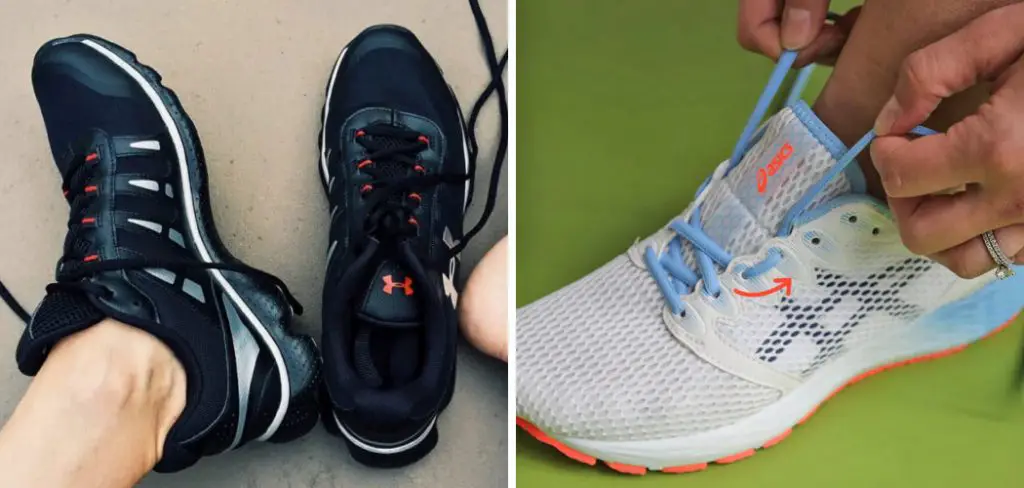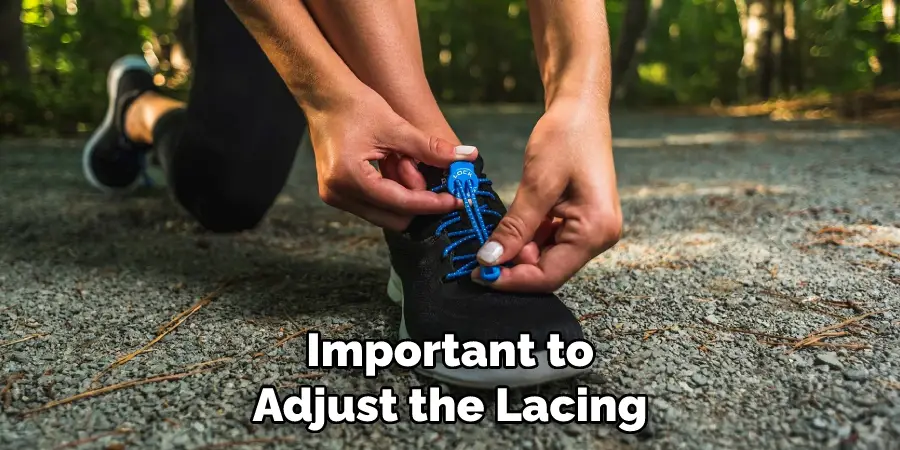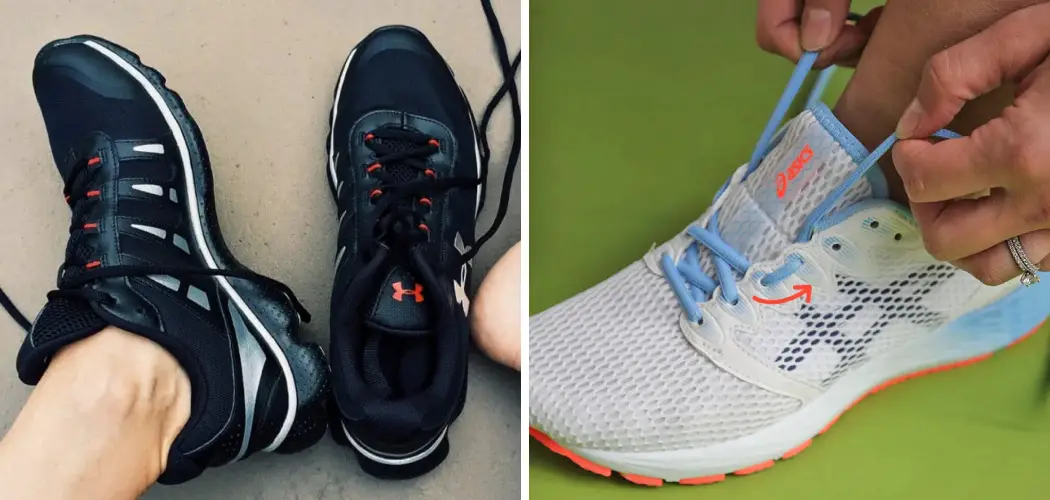Running can be a great way to keep fit and active, but it can also cause discomfort if your shoes are not properly laced. Wearing the wrong type of shoe or lacing them incorrectly can lead to numbness in your toes and feet that persists even after you stop running. That’s why it is important to know how to lace running shoes correctly to prevent and reduce numbness.

The lacing technique also helps support the arch of your foot, which helps alleviate strain on your feet and ankles. In this blog article, you can find step-by-step instructions on how to lace running shoes for numb toes.
Summary: To alleviate numbness or discomfort in your toes while running, it’s important to ensure your running shoes are laced properly. Start by loosening your laces and making sure your toes have some wiggle room. Next, use a runner’s loop technique to create more space in the toe box and reduce pressure on your toes. Finally, double-knot your laces to prevent them from becoming untied during your run.
Step-by-Step Processes for How to Lace Running Shoes for Numb Toes
Step 1: Inspect Your Running Shoes
Before you start lacing up your running shoes, inspect them for any potential areas of wear and tear that could cause further problems. Make sure the insoles are in good condition and well-padded, as this will provide cushioning and support. Start by threading the laces through the eyelets at the top of your shoes. Pull them tight and secure the knot.
Step 2: Create a Heel Lock (or “Runner’s Loop”)
This is an important step when it comes to lacing up running shoes. To create a heel lock, put one end of the lace over the other and thread them through the first pair of eyelets at the bottom of your shoes. Pull them tight and secure the knot. This will help lock your heel in place, minimizing movement and preventing numbness.
Step 3: Lace Your Shoes
Once you have created a heel lock, it is time to start lacing up your running shoes. Start by threading the laces through the second pair of eyelets on each side of your shoes. Pull them tight and tie a knot at the top of your running shoes, leaving some slack in the laces to ensure comfort.

Step 4: Adjust the Laces for Comfort
Once you have laced up your running shoes, it is important to adjust the laces to fit comfortably and securely. Pull the laces tight and pull them up towards your ankle. Make sure they are not too tight; a good rule of thumb is to slip one finger between your foot and the shoe. Also, make sure to tie a double knot at the top of your shoes to remain secure while running.
By following these simple steps, you can be sure that your running shoes are laced correctly and comfortably for numb toes.
Safety Tips for How to Lace Running Shoes for Numb Toes
- Make sure you select a running shoe that properly supports your feet. Consider buying fitting insoles or orthotics for additional comfort and cushioning if needed.
- Before lacing up, ensure that your foot is properly positioned in the shoe. Make sure the heel fits snugly, and your toes are not crunched at the tip of the shoe.
- Carefully lace up your running shoes, making sure to pull each eyelet tight so that your foot is adequately supported without causing excessive pressure on the numb areas of your toe.
- Once you’ve laced up your shoes, make sure to securely tie the laces so that the pressure does not cause additional discomfort or numbness in your toes.
- If your feet start feeling numb or uncomfortable during a run, stop and rest for a while. Also, changing socks periodically can help keep your feet dry and relieve numbness in the toes.
- Try out different lacing patterns to find one that works best for you to reduce the pressure on the affected areas of your feet.
- If you experience persistent numbness in your toes even after trying out various lacing techniques, then it is recommended to seek medical advice.
To keep your feet healthy and comfortable while running, following these safety tips for Lacking Running Shoes for Numb Toes will help make sure that your running shoes are properly laced and provide adequate support for your feet.

What Are Some Techniques for Adjusting the Lacing Tension on Your Running Shoes?
If you experience numb toes while running, the cause might be too much pressure on your foot. To reduce this pressure and alleviate numbness, you can make minor adjustments to the lacing tension of your running shoes. Some techniques for adjusting the lacing tension include using a ladder style or criss-cross pattern, reducing the tightness at the top, and adding more slack near the toes.
The ladder-style lacing technique involves running the laces of your shoes up through each eyelet in a linear pattern. This technique can benefit those with numb toes because it creates more uniform pressure throughout the foot instead of focusing too much pressure on one area. The criss-cross lacing technique can also be beneficial for those with numb toes. This technique involves running the laces in an alternating pattern, starting at the bottom eyelet and looping up to the top. This method helps distribute pressure more evenly over each part of your foot.
How Do You Use the Lacing Technique to Prevent Numb Toes Caused by Running?
The best way to prevent numb toes caused by running is to use the lacing technique. This simple method involves starting your lacing at the bottom eyelets and then crisscrossing the laces up the length of the shoe, making sure not to pull them too tight around each eyelet. The goal is to distribute pressure evenly across the top of the foot, preventing too much pressure on any one area. Additionally, special lacing techniques can be used to target numb toes and ensure that more pressure is alleviated from the toes.
One such technique is the “Runner’s Loop,” which involves creating a loop at the bottom eyelet before lacing up the shoe. This simply creates a small pocket at the bottom of your foot that relieves pressure from the toes. Additionally, this technique can be tailored to target specific areas, such as creating loops around each eyelet up to the affected area.
How Often Should You Adjust the Laces on Your Running Shoes to Keep Them From Becoming Too Tight?

If you’re prone to numb toes while running, it’s important to adjust the lacing of your running shoes frequently to ensure they are not too tight. How often you need to adjust the laces depends on various factors such as type of activities, type of shoes and individual foot shape. Generally speaking, if you feel that your running shoes are becoming too tight after a few runs, it is time to adjust the laces.
Adjusting your lacing requires more than just loosening or tightening the laces of your shoes. You should also check for pressure points that the lacing pattern on the top of your foot may cause. If you find any pressure points, you can use a different lacing pattern or technique to alleviate the pressure. Additionally, it’s important to check the length of your laces and ensure they are not too long or too short, as this can affect how tight your shoes feel on your feet.
How Can You Determine the Right Fit for Your Running Shoes to Prevent Numb Toes?
When choosing shoes for running, it’s important to make sure you have a pair that fits properly. Too tight shoes can lead to uncomfortable pressure on the toes and feet, which can cause numbness. To ensure your shoes fit properly and will not cause numbness in your toes, there are several steps you should take.
The first step in determining the right fit for your running shoes is to measure your feet. Measure them both lengthwise and widthwise to measure your foot size accurately. It’s also important to consider any existing medical conditions, such as bunions, plantar fasciitis, or hammertoes, that could affect your shoe size. Once you have the correct measurements for your feet, use a shoe sizing chart to select the right size for you.
The next step is choosing a running shoe with enough room for your toes. Try on shoes and ensure enough space in the toe box, so your toes don’t feel cramped. If you’re going to be running for long periods of time, make sure the shoes have plenty of cushioning in the sole and arch support, so your feet don’t get tired.

Conclusion
In conclusion, lacing your running shoes correctly can be the difference between an enjoyable and comfortable run and one of pain and discomfort. For those with numb toes, it’s especially important to avoid over-tightening the laces at any point along the foot, as this may cause further discomfort or even numbness. When in doubt, loosen your lacing somewhat to ensure your feet remain comfortable. I hope this article has been beneficial for learning how to lace running shoes for numb toes. Make Sure the precautionary measures are followed chronologically.

